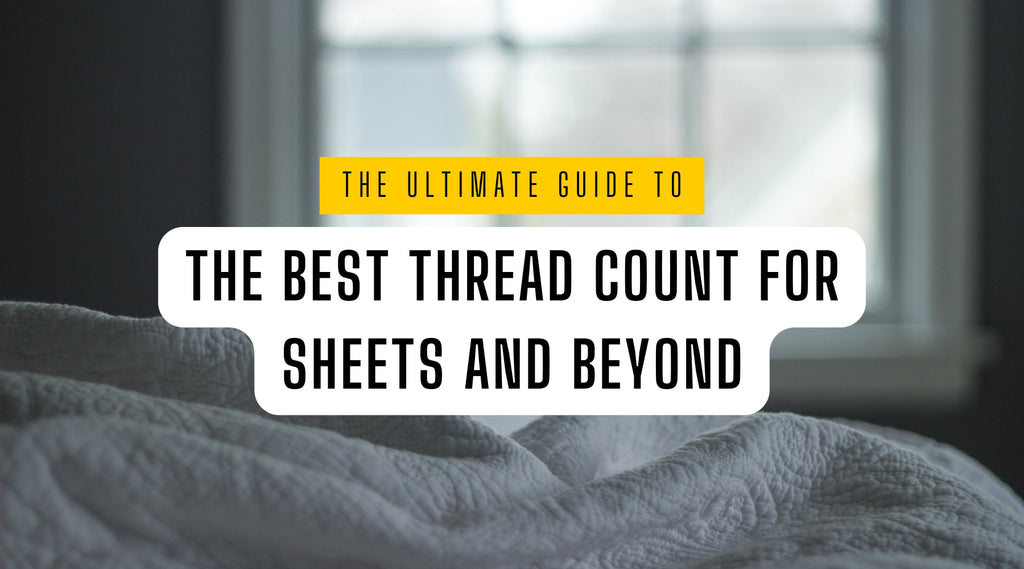The Ultimate Guide to The Best Thread Count for Sheets and Beyond
Posted by KABIR BAGGA

Finding the best bed sheets can drastically elevate your sleep quality, but with so many options available, it can be complicated to decide what to choose. While thread count is often marketed as the most important factor, it is just one piece of the puzzle. The type of fabric, the weave pattern, ply used, and even the quality of cotton play significant roles in the comfort and strength of the sheets.
The article talks through various aspects of bed sheet quality including what thread count truly means, how ply affects fabric, and how to choose the right sheets for your needs. By understanding them, you will be better prepared to select sheets that not only feel great but also fit for your needs and last for years to come.
What is thread count in a bedsheet?

Thread count in bedsheets represents the number of horizontal (weft) and vertical (wrap) threads intricately woven into each square inch of fabric. It is typically measured often to determine the softness and density of a bedsheet. However, a higher thread count does ot necessarily mean better quality; it also relies on other factors such as fabric type, yarn quality, weave type, and ply used.
For example, a 200 thread count cotton bedsheet is made of 100 horizontal and 100 vertical threads. However, the available space within every square inch of fabric is limited, you can’t weave a bedsheet tighter than the yarn and type of fabric being used allows; a linen bed sheet has inherently low thread count because linen fibers are naturally thicker and longer than cotton fibers. But, does it mean, linen sheets, typically made of 80-150 threads per square inch are not worth it? Not at all.
What is ply?

Ply is a technique used for creating a single, long thread, it generally refers to how many individual yarns are twisted together to make a single thread. Bedsheets can be made of single-ply or multi-ply threads, while single-ply is made from one strand of yarn, multi-ply forms by the twisting of two or more strands of yarn.
In single-ply sheets, one yarn is used per thread, which creates a softer, smoother fabric. Whereas, a 2-ply thread is created by combining two yarns together, creating a thicker, heavier fabric.
Ply plays a decisive role in determining the weight, feel and strength of the bedsheet. For instance, a single-ply, 300 thread count sheet consists of 300 threads, whereas a 2-ply 300 thread count sheet is actually only 150 individual threads.
How does ply impact thread count?

The ply used for a bed sheet directly affects its thread count. Manufacturers usually count all plys when calculating a sheet’s thread count which is in many cases irrelevant and misleading for the customers.
Some manufacturers use multi-ply threads to exaggerate sheet’s thread count, giving the impression of higher quality. However, the ACTUAL THREAD COUNT = MARKETED THREAD COUNT ÷ PLY.
|
MARKETED THREAD COUNT |
PLY |
ACTUAL THREAD COUNT |
|
600 |
3-Ply |
200 |
|
400 |
2-Ply |
200 |
|
200 |
1-Ply |
200 |
For example, if a 200 thread count sheet’s threads are made by combining two short fibers, to create one long fiber, it becomes a 400 thread count bed sheet instantly. However, it does not contribute to the sheet’s quality at all. If a sheet is made from multi-ply threads, it does not indicate better quality because the sheet consists of higher thread count.
This somewhat explains how sometimes a bed sheet made of higher thread count is not necessarily a higher quality bedsheet.
A single-ply cotton sheet of 300 thread count will feel more durable and luxurious than a 2-ply sheet of the same thread count. Because, the single-ply sheets have longer fibers and their weave is tighter. Multi-ply sheets may feel heavier but turn out less breathable and often lower in quality.
Is higher thread count always better?

The straight answer is a NO. Higher thread count is not always better. Though it is often marketed that way by manufacturers, excessively high thread count bedsheets are denser and can trap heat, turning out less breathable and uncomfortable which often do not align with many customers’ needs.
A good rule of thumb is to aim for a thread count between 300-500 that balances between comfort, softness, and durability. The type of fabric, ply, and weave often hold greater significance than thread count itself.
What is the best thread count for bed sheets?

As mentioned earlier, depending on the type of fabric and weave, you can decide what thread count for bedsheets is ideal. Below is a thread count comparison table which explains different fabric, their characteristics, pros, cons and optimal thread count range, to help you choose the best sheet option based on your bedding needs:
|
FABRIC TYPE |
OPTIMAL THREAD COUNT |
FABRIC CHARACTERISTICS |
PROS |
CONS |
|
Regular Cotton |
200-400 |
Common, shorter fibers |
Affordable, soft |
Less durable than longer fiber cotton |
|
Egyptian Cotton |
300-400 |
Plush, soft, long fibers |
Soft, breathable, durable |
Expensive |
|
Pima Cotton |
300-500 |
Soft, silky, strong |
Durable, silky, good for hot sleepers |
Costs higher than regular cotton |
|
Linen |
80-150 |
Breathable, temperature-regulating, coarse texture |
Excellent for hot weather |
Naturally wrinkly, lower thread count |
|
Bamboo |
250-350 |
Soft, moisture-wicking, eco-friendly |
Soft, hypoallergenic |
May be expensive, prone to wrinkles |
|
Silk |
300-600 |
Plush, smooth, hypoallergenic |
Soft, temperature regulating |
Expensive, delicate, prone to tears |
|
Microfiber |
90-120 GSM |
Synthetic fibers, often polyester, nylon, acrylic, rayon |
Highly soft, durable, affordable |
Less breathable, may trap heat |
|
Flannel |
160-190 GSM |
Soft, brushed cotton or wool |
Warm, soft, appropriate for cold weather |
Can be excessively warm for hot sleepers |
|
Percale Weave |
200-300 |
Crisp, cool, matte finish |
Lightweight, ideal for hot sleepers |
Less soft than sateen |
|
Sateen Weave |
300-600 |
Smooth, silky, shiny finish |
Plush, soft |
Less breathable, prone to pilling |
|
Twill Weave |
200-300 |
Durable, diagonally ribbed pattern |
Strong, good for cold weather |
Less breathable, heavy |
|
Polyester Blends |
200-300 |
Wrinkle-resistant, synthetic fabric |
Durable, affordable |
Less breathable than natural fibers |
How does thread count affect quality?

Thread count in a bedsheet determines its softness, texture and durability. But, it is not the only factor impacting the sheet’s quality. For instance, sheets with extremely high thread count (over 600) may feel dense and less breathable, while a lower thread count (between 200-400) in a high-grade fabric such as Egyptian cotton will be softer, more breathable, and last longer.
Well, to provide you with a clear idea of when you may need a high or a low thread count bedsheet, we have created a table which explains the quality of linen based on their thread count and what use they are best suited for:
|
QUALITY OF LINEN |
THREAD COUNT |
SUITABLE FOR |
|
Basic |
80-150 |
Budget-friendly, short-term use |
|
Good |
150-250 |
Comfortable, regular use |
|
Excellent |
250-400 |
Durable, long-term use |
|
Best |
400-600 |
High-end, hotels and hospitality use |
What other factors affect the quality of bedsheets?

Apart from thread count, there are a number of factors that play a decisive role in impacting the quality of a bedsheet which are:
Quality of cotton
Cotton grade and softness is determined by the length of its fibers, otherwise called “staple length”. Longer fibers result in smoother, stronger, and highly durable sheets:
|
LONG STAPLE COTTON (EGYPTIAN OR PIMA) |
SHORT-STAPLE COTTON |
|
Known for making luxurious, soft, and highly durable sheets, long-staple cotton creates fewer exposed fiber ends in sheets, resulting in less pilling and a smoother texture. |
While affordable, short-staple cotton tends to pile faster and fray, making sheets made with them comparatively less durable and slightly rough. |
Type of weave
The way fibers are woven together impacts the texture, feel and breathability of the sheet. The three most common fabric weave style for bedsheets are:
|
PERCALE WEAVE |
SATEEN WEAVE |
TWILL WEAVE |
|
A basic one-over, one-under weave that makes a crisp, lightweight and airy fabric. Best suited for hot sleepers and warm weather. |
A one-under, three-over weave that creates a shining-soft, silky-finish fabric. Sateen sheets feel plush and have a smooth texture but less breathable than percale weave. |
A diagonal weave that creates a heavy and durable but less breathable fabric. Best suited for cold weather. |
Fabric manufacturing and finishing
The way sheets are processed after weaving plays a significant role in how the end-product feels and lasts. Sheets go through numerous treatments during manufacturing and finishing such as:
|
COMBING |
MERCERIZING |
|
This process filters out short fibers and any impurities leaving only the strongest, longest fibers for a smoother, high quality finish. |
It is a chemical treatment that increases the strength, glow and dye absorption of cotton, resulting in a fabric, shinier and resistant to wear. |
Quality of stitching
The seams and hems of bedsheet are often overlooked but dramatically impact its longevity. Well-made sheets feature tight, uniform stitching and reinforced edges designed to resist fraying with use over time. Such sheets have double-stitching or hemming around the edges, giving better durability. For fitted sheets, deep pockets and high-quality elastic is used for preventing them from slipping off the mattress, elevating ease of use.
Quality of dyes
The quality of dyes used on bedsheets impacts how vibrant the color will be and how well it holds up to the sheets despite regular washing. Common types of dyes used on bed sheets are:
|
REACTIVE DYES |
PIGMENT-BASED DYES |
|
These dyes react chemically and bond to the fabric, producing vibrant, long-lasting colors that endure through multiple washes. |
These dyes rest on the fabric’s surface, making them prone to fading and washing out over time. |
Note: Quality bedsheets use reactive dyes rather than pigment-based dyes, because such sheets guarantee vibrant, long-lasting colors.
The Takeaway

When it comes to choosing a bedsheet for yourself, there are several other factors to notice more than the thread count. Though the thread count can change a sheet’s softness of lifespan, other factors such as the type of fabric used, its fiber quality, and the adopted finishing process play equally important roles in deciding the sheet’s coziness and lifespan. The key is to choose sheets that align with your personal needs and sleeping habits. In the end, the best bedsheets are those which feature a balance between quality, comfort and practicality for you.

